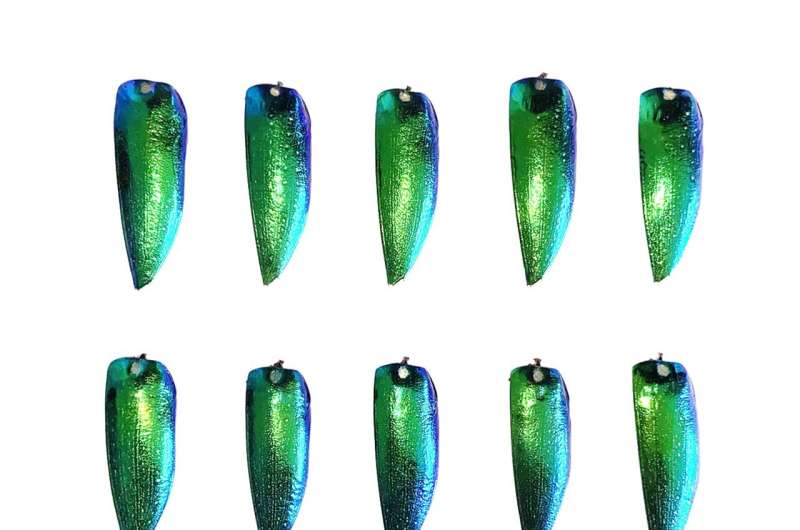This article has been reviewed according to Science X's editorial process and policies. Editors have highlighted the following attributes while ensuring the content's credibility:
fact-checked
peer-reviewed publication
trusted source
proofread
Gloss is less effective camouflage in beetles compared to matte, according to study

When combined with iridescent coloration, a matte target surface appearance confers greater survival benefits in beetles than a glossy surface, scientists at the University of Bristol have found.
The findings, published in Behavioral Ecology, suggest that iridescence provides camouflage independent of glossiness, which means that it is the color of iridescent surfaces and its changeability, that is the most important aspect of iridescence in enabling camouflage.
Iridescence is a type of structural coloration that produces bright, vibrant hues. These are often angle-dependent, meaning the observed color appears to change depending on the viewing angle.
Lead author Dylan Thomas from Bristol's School of Biological Sciences, said, "This is somewhat surprising. Recent theories had suggested prey target gloss could be important in concealment, but our findings actually suggest the opposite to be true.
"In other words, perhaps glossiness isn't as important to camouflage as had previously been suggested."
The team produced artificial beetle targets and pinned these to trees in Leigh Woods in Bristol and observed how well they survived under predation by natural bird predators.
Half were sprayed with a glossy fixative and half a matte fixative. They were fixed to ivy leaves, placing a mealworm between the target and the leaf, and secured against tree roots or trunks. The targets were checked at 24-hour intervals over a 96-hour period for signs of bird predation—if the mealworm had been eaten, the target was classed as having been predated.
When collecting targets, they also selected the background leaves for analysis as a previous study had found that background gloss has a significant effect on target survival.
Dylan explained, "Our results provide further evidence that iridescent coloration can provide effective camouflage.
"They also support previous findings that background glossiness has a significant effect on target survival—when targets are on a glossy background, their survival is enhanced."
Now the team plan to further explore why so many beetle species are glossy, given it is detrimental to their survival when combined with iridescence.
They will also look at why black targets seem to survive well (second behind iridescence), the effects of background gloss and how lighting conditions affect how iridescence and gloss are perceived.
Dylan concluded, "Our findings contribute to a widening literature on camouflaging iridescence and help us to better understand the role this distinctive form of coloration can have in concealment.
"Our findings have also opened many avenues for further research, many of which are important not just to iridescence as camouflage but to camouflage as a whole."
More information: Dylan H N Thomas et al, Interactions between color and gloss in iridescent camouflage, Behavioral Ecology (2023). DOI: 10.1093/beheco/arad050
Journal information: Behavioral Ecology
Provided by University of Bristol



















